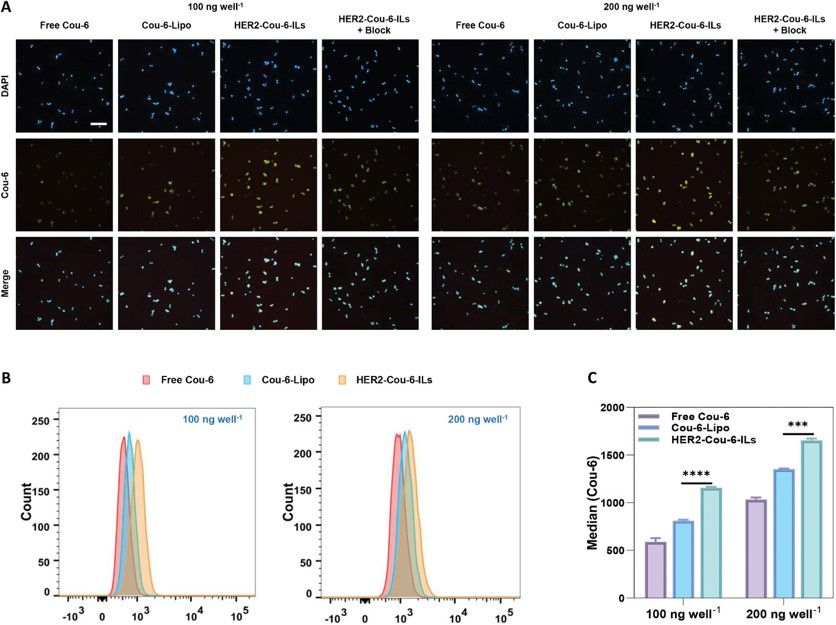Immunoliposome Products
Product Details Technical Note Publish Data FAQs Resources
Product Details
Creative Biolabs is offering a wide range of customized immunoliposomes products with innovative liposome development platform for both academic and industrial clients.
Liposomes have been actively investigated as drug delivery vehicles. Immunoliposome is a novel method artificially prepared spherical vesicles composed of a lamellar phase lipid bilayer, which provides several diagnostic advantages by the tagged antibodies on their outer surfaces. Liposomes lack the ability to targeted delivery of drugs into a specific cell type, while immunoliposomes can achieve targeted delivery by conjugating some antibody fragments to the surface of them. These mAb fragments provide immunoliposomes to bind and internalize into the target cell with high specificity.
Our immunoliposomes can be used to develop antibody-liposomes conjugate to selectively target antigen-expressing cells, which can deliver drugs to tumor cells for improving efficacy and reducing toxicity. In addition, immunoliposomes can also be used in immunoassays and imaging. Immunoliposomes have been extensively applied in the treatment of a variety of diseases such as Alzheimer’s disease, in which immunoliposomes are conjugated to anti-transferrin receptor and anti-Aβ mAbs.

For Research Use Only. Not For Clinical Use
Technical Note
-
EDC and Sulfo-NHS must be prepared immediately prior to use and kept at room temperature. Dialysis cassettes and spin columns mustn't be used without considering their size variants. The immunoliposome solution should be dialyzed in PBS at pH 7.4. Avoid using Tris buffers due to their amine content.
-
Hydrophobic ligands or peptides are recommended to be dissolved in DMSO or DMF, with a limit of 5% of the solution. Post-conjugation, any residual DMSO or DMF should be removed using a dialysis cassette made of regenerated cellulose membrane.
-
Azides must be avoided in buffers during conjugation since they may react with DBCO. For optimum DBCO-azide reactions, use higher concentrations at warmer temperatures (up to 37°C). However, refrigerate molecules after liposome incubation to prevent their denaturation. Extending reaction times beyond the typical 12 hours can increase efficiency.
-
Conjugation of DBCO-lipid conjugated ligands post-conjugation enhances immunoliposome yield to over 80%. Also, Folate-contained liposomes target cells' folate receptors, more specifically in creating immunoliposomes with FBP-tagged antibodies/proteins or ligands.
-
18:1 DGS-NTA(Ni) lipid concentration is recommended at a maximum of 3% to prevent nonspecific binding. High imidazole's presence can inhibit binding reactions.
-
Liposomes after conjugation reactions containing excess maleimide or thiol groups can cause issues; these can be quenched with appropriate reagents. Follow an inert atmosphere during coupling to prevent oxidation of sulfhydryl, keep pH between 6.5 and 7, and use liposomes with maleimide reactive lipids for thiolated protein conjugation.
-
In assays involving liposomes coated with biotinylated ligands or peptides ensure that the streptavidin: biotin-liposome ratio is optimized. Insufficient streptavidin can lead to poorly coated liposomes, resulting in lower sensitivity or specificity in assays. While size-exclusion spin columns can separate unbound ligands from liposomes, liposome adhesion to the column matrix can lead to significant loss.
-
Liposome storage should maintain a constant 4°C without any freezing circumstances to maintain their efficacy.
Publish Data
Anti-HER2 Immunoliposomes: Antitumor Efficacy Attributable to Targeted Delivery of Anthraquinone-Fused Enediyne
Author: Feng, Xueqiong, et al.
This study investigates the targeted delivery effect of immunoliposomes (ILs) on cargo. Antibody binds specifically to HER2, which is highly expressed in tumor cells, and can be used to prepare HER2-ILs. Researchers incorporated a fluorescent probe (coumarin-6, Cou-6) into HER2-ILs to create HER2-Cou-6-ILs for studying ILs internalization. Compared to free Cou-6 and Cou-6-Lipo, HER2-Cou-6-ILs can be internalized into KPL-4 cells (which overexpress HER2) in a dose-dependent manner. However, upon saturation with antibody, the fluorescence accumulation in KPL-4 cells decreases. This suggests that antibody can enhance the cell uptake of ILs in target cells. The utilization of ILs in this study highlights their potential to improve cancer therapy by offering targeted drug delivery platforms.
 Fig.1 Cell uptake of free Cou-6, Cou-6-Lipo, and HER2-Cou-6-ILs in KPL-4 cells.1,2
Fig.1 Cell uptake of free Cou-6, Cou-6-Lipo, and HER2-Cou-6-ILs in KPL-4 cells.1,2
FAQs
What are immunoliposomes and how do they work?
Immunoliposomes are a type of targeted drug delivery system that combines the versatility of liposomes with the specificity of antibodies. They consist of lipid bilayers that encapsulate therapeutic agents, with antibodies attached to their surface. These antibodies recognize and bind to specific antigens on the target cells, allowing for targeted delivery of the encapsulated drugs.
What advantages do immunoliposomes offer in research?
Immunoliposomes offer several advantages in research, including enhanced targeting specificity, reduced systemic toxicity, and improved drug solubility. They allow for the precise delivery of drugs to specific cell types or tissues, which is particularly useful in studying diseases with well-defined molecular targets.
What types of research applications are immunoliposomes suitable for?
Immunoliposomes are suitable for a wide range of research applications, including cancer therapy, targeted gene delivery, and immunotherapy. They are particularly useful in studying diseases where targeted delivery can enhance therapeutic efficacy and reduce off-target effects.
How are immunoliposomes prepared and characterized?
Immunoliposomes are prepared by conjugating antibodies to the surface of liposomes, typically using chemical cross-linking methods. Characterization involves assessing their size, charge, stability, antibody conjugation efficiency, and drug encapsulation efficiency. Techniques such as dynamic light scattering, transmission electron microscopy, and surface plasmon resonance are commonly used.
Resources
References
-
Feng, Xueqiong, et al. "Anti‐HER2 Immunoliposomes: Antitumor Efficacy Attributable to Targeted Delivery of Anthraquinone‐Fused Enediyne." Advanced Science 11.17 (2024): 2307865.
-
under Open Access license CC BY 4.0, without modification.

For Research Use Only. Not For Clinical Use
 For Research Use Only. Not For Clinical Use
For Research Use Only. Not For Clinical Use
 Fig.1 Cell uptake of free Cou-6, Cou-6-Lipo, and HER2-Cou-6-ILs in KPL-4 cells.1,2
Fig.1 Cell uptake of free Cou-6, Cou-6-Lipo, and HER2-Cou-6-ILs in KPL-4 cells.1,2
 For Research Use Only. Not For Clinical Use
For Research Use Only. Not For Clinical Use
